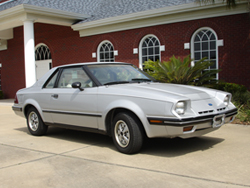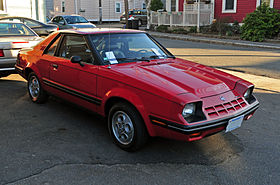Ford EXP
| Ford EXP | |
|---|---|
 |
|
| Overview | |
| Manufacturer | Ford |
| Also called | Mercury LN7 |
| Production | 1981–1988 |
| Model years | 1982–1988 |
| Assembly |
Wayne, Michigan (Wayne Stamping & Assembly) Milpitas, California (San Jose Assembly) St. Thomas, Ontario, Canada (St. Thomas Assembly) |
| Body and chassis | |
| Class | Sport compact |
| Body style | 3-door hatchback |
| Layout | FF layout |
| Platform | Ford CE14 platform |
| Related |
Ford Escort Mercury Lynx Ford Tempo Mercury Topaz |
| Chronology | |
| Successor | Ford Probe |
| First generation | |
|---|---|

Mercury LN7
|
|
| Overview | |
| Also called | Mercury LN7 |
| Model years | 1982–1985 (EXP) 1982–1983 (LN7) |
| Powertrain | |
| Engine | 1.6 L CVH I4 |
| Transmission | 4-speed IB4 manual 5-speed MTX-III manual 3-speed FLC automatic |
| Dimensions | |
| Wheelbase | 94.2 in (2,393 mm) |
| Length | 170.3 in (4,326 mm) |
| Width | 65.9 in (1,674 mm) |
| Height | 50.5 in (1,283 mm) |
| Curb weight | 2,047 lb (929 kg) |
| Second generation | |
|---|---|
 |
|
| Overview | |
| Also called | Ford Escort EXP |
| Model years | 1985.5–1988 |
| Powertrain | |
| Engine | 1.9 L CVH I4 |
| Transmission | 4-speed IB4 manual 5-speed MTX-III manual 3-speed FLC automatic |
| Dimensions | |
| Wheelbase | 94.2 in (2,393 mm) |
| Length | 170.3 in (4,326 mm) |
| Width | 65.9 in (1,674 mm) |
| Height | 50.5 in (1,283 mm) |
| Curb weight | 2,388 lb (1,083 kg) |
The Ford EXP is a sports compact coupe that was produced and sold by Ford Motor Company in North America from the 1982 to 1988 model years. The first two-seat Ford since the 1957 Thunderbird, the EXP made its debut at the 1981 Chicago Auto Show. Sharing a wheelbase and powertrain with the Ford Escort, the EXP was longer, lower, and more aerodynamic than its five-seat counterpart. Some EXP owners have been known to remove the rear carpeting to put in rear seats as the floor pans are identical between the 3-door Escorts, Escort GTs, and EXPs.
In line with the first-generation Escort, the EXP was produced in a version from 1982 to 1985, undergoing a facelift during the 1985 model year. The model was dropped after the 1988 model year. Although not intended to replace the EXP (as it was originally designed to become the 1989 Ford Mustang), the 1989 Ford Probe would become the next front-wheel drive sports coupe sold by Ford. After the EXP, the next two-seat Ford marketed in North America would be the 2002 Ford Thunderbird. Then in 1998 the Escort of the time was marketed as a ZX2, to help reel in consumers that favored the XR2 and the EXP from the 1980s.
From 1982 to 1983, the EXP was sold by Lincoln-Mercury dealers as the Mercury LN7. The LN7 was distinguished largely by its "bubbleback" hatch , large bumper strips across the doors , "black-out" tail lights, and more slits in the nose clip than those of an EXP. The vehicle however, was dropped after failing to meet sales expectations.
By 1980, Ford Motor Company had entered a period of major transition. Following the termination of Lee Iaccoca (to become CEO of Chrysler), chairman Henry Ford II retired and Ford Chief Stylist Eugene Bordinat stepped down as well.
During the late 1970s, there had been a push by automobile manufacturers around the world to make small, fuel efficient cars; this was initiated by the OPEC oil embargo of October 17, 1973–1974. This embargo included a 70% increase in oil prices, causing long lines at gasoline filling stations, and skyrocketing prices for gasoline. People wanted, demanded more miles for their gasoline dollars. By the end of the decade, this led auto manufacturers from the United States, Japan, and West Germany to rethink the adage that "bigger is better".
...
Wikipedia
